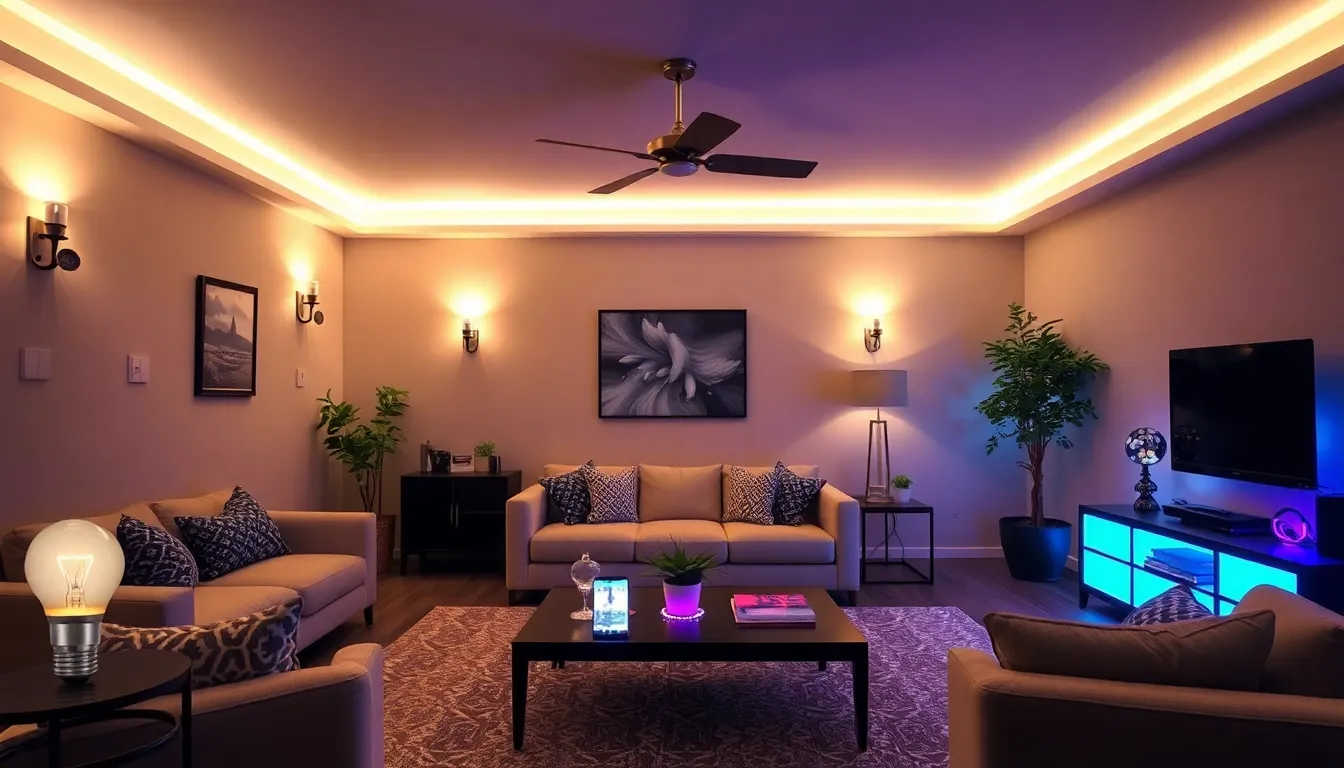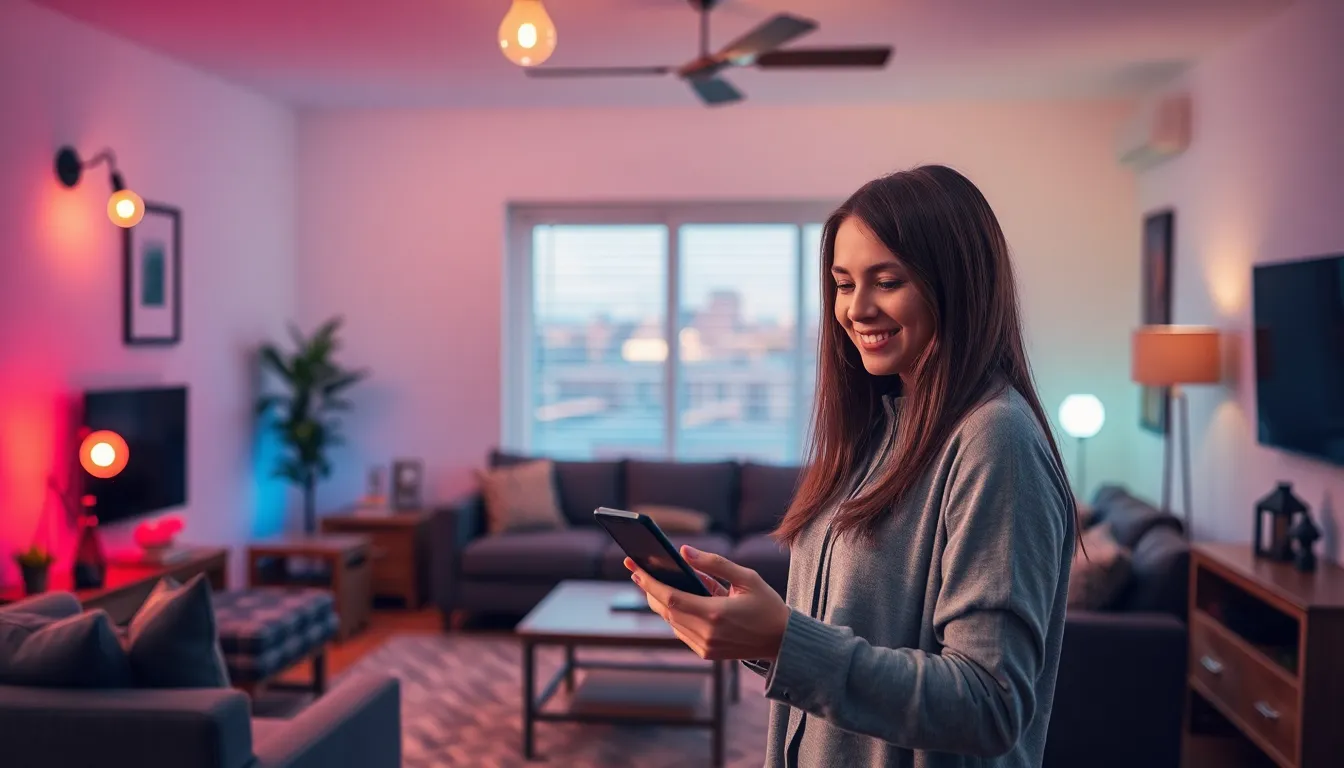In a world where even your toaster can connect to the internet, why should your lights stay in the dark ages? Smart lighting solutions are here to brighten up not just your home but your life. Imagine walking into a room and having the lights adjust just the way you like them, all while you’re still juggling your groceries. Talk about a glow-up!
Table of Contents
ToggleOverview of Smart Lighting Solutions
Smart lighting solutions revolutionize how individuals experience illumination within their environments. These systems enable users to customize lighting settings according to specific activities or preferences. They often include features such as remote control, scheduling, and even integration with other smart home devices.
Energy efficiency stands out as one of the primary benefits of smart lighting. LED bulbs frequently utilized in these systems consume significantly less energy than traditional incandescent options. They reduce electricity costs by up to 80%, promoting sustainability in homes while maintaining optimal brightness levels.
Automated adjustments enhance comfort and convenience. Smart lights can sense when rooms are occupied and switch on or off accordingly. Motion sensors allow for seamless transitions, ensuring lights create a welcoming atmosphere upon entering a space.
Users can access smart lighting features via mobile apps or voice commands. Compatibility with voice assistants like Amazon Alexa or Google Assistant adds another layer of convenience, allowing individuals to control their environment effortlessly. The potential for customization also exists, from choosing colors to adjusting dimmer settings.
Smart lighting solutions improve security as well. Homeowners can set up timers to mimic their presence when away, deterring potential intruders. By simulating occupancy, these systems contribute to a safer living environment.
Overall, smart lighting solutions offer innovative technology to enhance everyday living. With their array of features, they cater to the needs of modern households while remaining energy efficient and easily customizable.
Types of Smart Lighting Solutions

Smart lighting solutions come in various forms, each offering unique benefits and functionalities.
Smart Bulbs
Smart bulbs provide users with customizable lighting options. They connect to Wi-Fi, allowing for remote control and scheduling through mobile apps. Features often include adjustable brightness and color options. Many smart bulbs are compatible with voice assistants, enabling hands-free operation. Energy-efficient LED technology ensures long-lasting performance while reducing electricity costs. Examples include Philips Hue and LIFX, which offer extensive integration with smart home ecosystems.
Smart Switches
Smart switches replace standard wall switches, providing users with enhanced control over existing lighting fixtures. These devices connect to Wi-Fi and allow scheduling or remote access through mobile applications. Smart switches often support dimming features, enabling users to set the mood effortlessly. Different models may offer compatibility with voice assistants or smart home platforms. Notable brands include Lutron Caséta and Wemo, known for seamless integration and user-friendly interfaces.
Smart LED Strips
Smart LED strips offer versatile lighting solutions for various spaces. These flexible strips can be mounted under cabinets, around furniture, or along walls to create dramatic effects. Users can customize colors, brightness, and patterns through mobile apps. Many smart LED strips work with voice commands, enhancing user convenience. Popular options include Philips Hue Lightstrip Plus and Govee LED Strip Lights, which allow for dynamic backlighting and mood creation.
Benefits of Smart Lighting Solutions
Smart lighting solutions offer multiple advantages, transforming how individuals interact with their home environment. These benefits include energy efficiency, convenience, and enhanced aesthetics.
Energy Efficiency
Energy efficiency is a primary advantage of smart lighting solutions. LED bulbs use less power compared to traditional incandescent bulbs, allowing households to reduce electricity costs by up to 80%. Sensors detect when rooms are occupied, ensuring lights only operate when needed, minimizing energy wastage. Smart lighting systems can be programmed to adjust brightness levels according to natural light availability, further optimizing energy consumption. Users often notice a significant decrease in their energy bills, reinforcing the value of investing in these advanced systems.
Convenience and Automation
Convenience defines smart lighting solutions, as homeowners access their lights through mobile apps or voice commands. These systems enable remote control, allowing users to adjust lighting settings from anywhere. Automation simplifies routine tasks; lights can be programmed to turn on or off at specific times or triggered by motion sensors. Individuals entering a room with hands full benefit from automatic adjustments. Integration with other smart home devices creates a seamless experience, enhancing daily comfort and efficiency.
Enhanced Aesthetics
Enhanced aesthetics represent another compelling benefit of smart lighting solutions. Customizable lighting settings allow users to create specific moods for various occasions. Smart bulbs and strips change colors and brightness levels to match the atmosphere of any event, from a cozy family dinner to a lively party. The versatility of smart lighting encourages creative applications in home decor, giving each space a unique character. Users appreciate how strategically placed lighting enhances architectural features, adding depth and dimension to their environment.
Challenges in Implementing Smart Lighting Solutions
Smart lighting solutions face several challenges during implementation. Understanding these hurdles is essential for a successful integration.
Compatibility Issues
Compatibility issues often arise when integrating smart lighting systems with existing home setups. Not all devices work seamlessly together, creating frustration for users. Various smart lighting products require specific hubs or protocols, which limits options for homeowners. Some older fixtures and switches might need replacements to accommodate new technologies as well. Users frequently encounter issues when trying to connect devices from different manufacturers, leading to a non-optimal experience. These compatibility challenges can deter potential adopters from fully transitioning to smart lighting solutions.
Cost Considerations
Cost considerations play a significant role in the decision-making process for smart lighting solutions. Initial investments can be substantial, especially when updating entire home systems. High-quality smart bulbs and switches carry premium prices that add up quickly, making budgeting a concern. Upgrading existing fixtures further increases costs, along with potential installation fees for more complex setups. While long-term savings on energy bills provide some financial relief, upfront expenses can deter homeowners. Careful evaluation of needs and potential costs is essential to ensure a worthwhile investment in smart lighting.
Smart lighting solutions represent a transformative step in home technology that enhances both functionality and aesthetics. By offering customizable settings and energy-efficient options, these systems cater to modern lifestyles while promoting convenience and comfort. The integration of smart lighting with other home devices further amplifies its benefits, creating a cohesive and innovative living environment.
Despite some challenges such as compatibility and initial costs, the long-term advantages make smart lighting a worthwhile investment. As homeowners seek to elevate their living spaces, embracing smart lighting solutions can lead to a more efficient and enjoyable home experience. With continuous advancements in this technology, the future of illumination looks brighter than ever.




